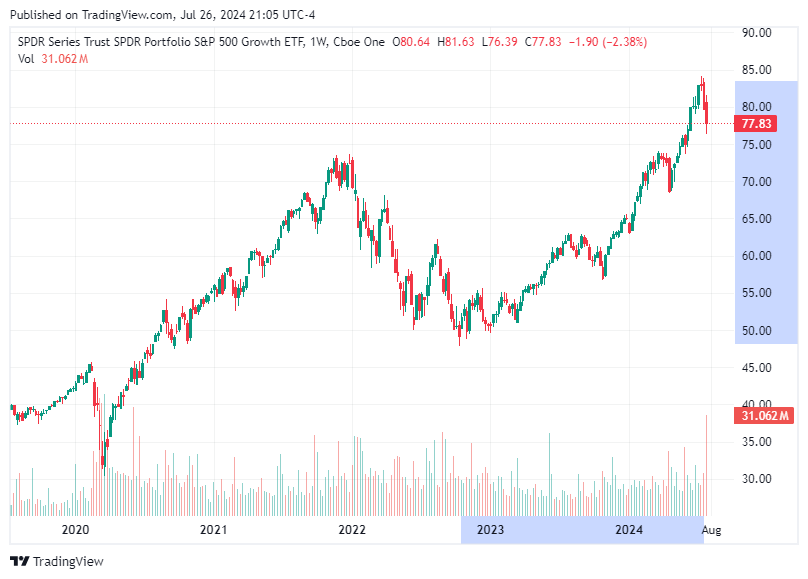Dow Jones Surges Over Strong GDP Data
Dow Industrials Rise Following Strong GDP Data; Smaller Companies Outperform.

Disclaimer: This article is for informational purposes only and should not be considered as financial or investment advice. Readers should conduct their own research and consult with a professional before making any investment decisions.
Real-time information is available daily at https://stockregion.net
The financial markets experienced notable movements on Friday, driven by an unexpectedly strong report on the U.S. Gross Domestic Product (GDP). The positive economic data contributed to an increase in the Dow Industrials and saw smaller companies outperforming their larger counterparts, continuing a trend of stock-market rotation.
Market Performance on Friday
On Friday, the Dow Jones Industrial Average surged by 654.27 points, or 1.64%, concluding the trading day at 40,589.34. Similarly, the S&P 500 climbed 1.11% to finish at 5,459.10, while the Nasdaq Composite gained 1.03% to close at 17,357.88. The positive moves were attributed to several factors, including a prevailing oversold sentiment, robust GDP data released on Thursday, and growing expectations that the Federal Reserve might begin cutting interest rates due to a resilient economy.
GDP Data: The stronger-than-expected GDP data released on Thursday provided a boost to investor confidence. The economic growth surpassed analyst predictions, showing the resilience of the U.S. economy. This report played a critical role in shaping market sentiment, as investors reassessed their positions in light of the new information.
Another pivotal factor was the personal consumption expenditures (PCE) price index for June, which is a key measure of inflation preferred by central bank policymakers. On a monthly basis, the headline PCE rose by 0.1%, translating to a 2.5% increase from a year ago. These figures met the expectations of economists polled by Dow Jones and reinforced the perception that inflationary pressures might be easing. The anticipation of lower inflation has fueled hopes that the Federal Reserve will implement rate cuts later this year. According to the fed funds futures market, there is a high probability of rate cuts in September, November, and December. Ken Mahoney, president of Mahoney Asset Management, emphasized that the data reflected tamer inflation numbers, suggesting that rate cuts are likely imminent.
Sector Performance
The market's reaction was characterized by a rotation into cyclical areas and small-cap stocks. The Russell 2000, which tracks smaller companies, rose by 1.67%. Additionally, industrials and materials stocks experienced gains, lifting their respective S&P sectors by approximately 1.7%.
Among individual stocks, 3M had a remarkable day, skyrocketing by 23%, marking its best performance since at least 1972. The surge followed better-than-expected earnings reports, propelling the industrials sector upward. Notably, some technology names that had struggled earlier in the week also posted gains. Microsoft and Amazon each added over 1%, while Meta Platforms saw an increase of nearly 3%. The information technology sector of the S&P 500 surged by about 1%. Despite Friday's gains, the week was marked by volatility. The S&P 500 registered a decline of 0.8%, and the Nasdaq lost 2.1%, both indexes posting back-to-back weekly losses for the first time since April. In contrast, the Dow outperformed by adding 0.8%, achieving its fourth consecutive positive week for the first time since May.
The action throughout the week suggested that investors were pivoting towards small caps and cyclicals, indicative of a broader shift in market dynamics. For instance, Dexcom, a medical device maker, plunged by 41% following disappointing fiscal full-year guidance. Conversely, Deckers, a footwear company, reported fiscal first-quarter earnings and revenue that surpassed analysts’ expectations, resulting in a 6% rise in shares.
For Investors
The market movements highlighted above shos critical implications for investors:
Economic Resilience: The stronger-than-expected GDP data suggests that the U.S. economy remains robust despite various headwinds. This resilience is likely to influence investment strategies, with a potential focus on sectors that benefit from economic growth.
Inflation and Interest Rates: With inflation data coming in line with expectations and the prospect of the Federal Reserve cutting rates, the investment landscape could shift. Lower interest rates typically benefit equities, particularly growth stocks, as the cost of borrowing decreases and future earnings become more valuable.
Sector Rotation: The ongoing rotation into cyclical stocks and small caps indicates a changing market sentiment. Investors may look to diversify their portfolios to include sectors poised to benefit from economic expansion and higher consumer spending.
Stock-Specific Movements: Individual stock performances continue to be influenced by earnings reports and company-specific news. As seen with 3M and Dexcom, investors must remain vigilant about corporate announcements that can impact stock prices.
The surge in the Dow Industrials and the outperformance of smaller companies highlight a dynamic period in the financial markets, driven by stronger-than-expected GDP data and favorable inflation readings. While the broad market indices posted gains, sector-specific movements and individual stock performances revealed the importance of nuanced investment strategies.
Investors should closely monitor economic indicators and Federal Reserve policies as they navigate the evolving market landscape. By staying informed and adaptable, they can position themselves to capitalize on emerging opportunities and mitigate potential risks.
Disclaimer: The information provided in this article is for informational purposes only and does not constitute financial or investment advice. Readers are encouraged to conduct their own research and seek professional guidance before making any investment decisions.
Real-time information is available daily at https://stockregion.net




